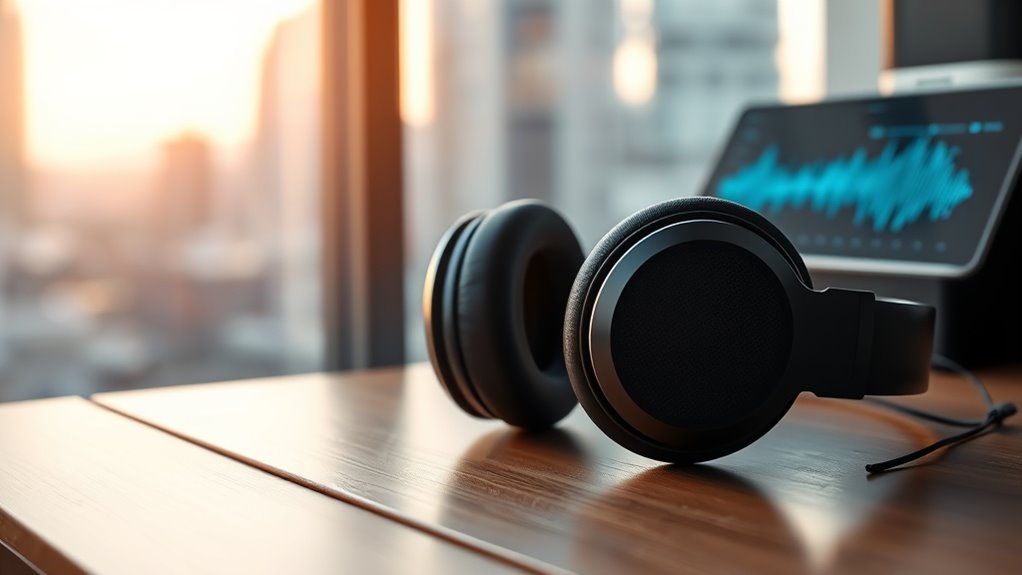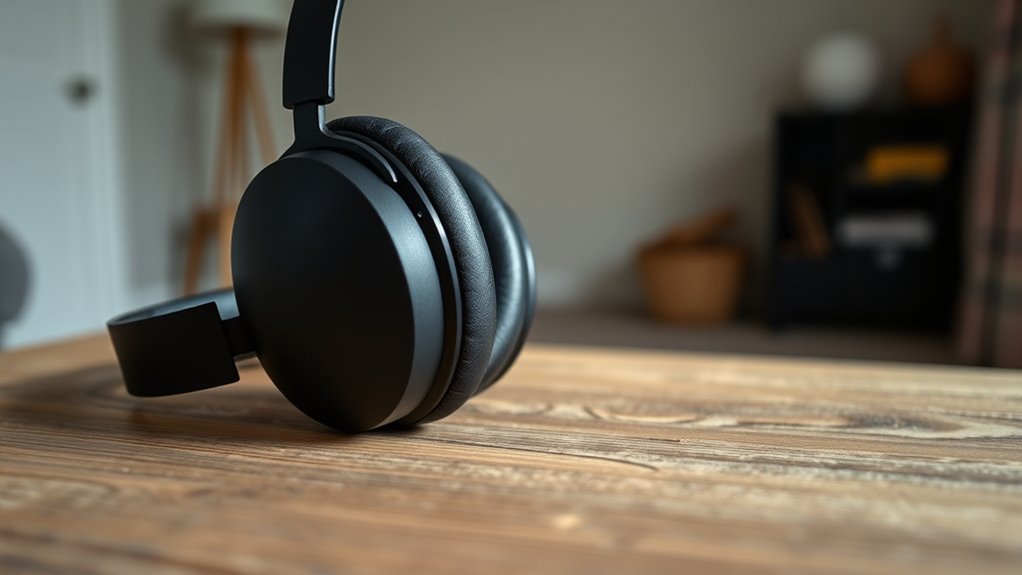Noise-cancelling tech works by analyzing external sounds with built-in microphones and generating anti-noise waves that are the exact opposite of unwanted noise. These anti-phase signals cancel out background disturbances, creating a quieter environment for you. Adaptive systems adjust these signals in real time to handle changing noise levels, ensuring consistent sound quality. Behind this process are advanced digital signal processing and machine learning, making your experience smoother. If you keep exploring, you’ll discover how these innovations keep noise at bay and audio crystal clear.
Key Takeaways
- Noise-cancelling headphones use microphones to detect external sounds and generate anti-phase sound waves to cancel noise.
- Adaptive noise reduction continuously adjusts anti-noise signals based on real-time environmental sound changes.
- Digital signal processing and machine learning help distinguish unwanted noise from desired audio for clearer sound.
- Components like microphones, algorithms, and DSP work together to actively filter and balance noise reduction with sound quality.
- This technology creates a quieter environment, enhancing listening comfort and preserving important sounds through advanced engineering.

Have you ever wished you could block out noisy surroundings and focus completely on what matters? That’s where noise-cancelling technology comes in. At its core, noise cancellation relies heavily on audio signal processing, a sophisticated method that analyzes sound waves in real time. When you put on a pair of noise-cancelling headphones, they don’t just blindly block sound; they actively listen to what’s around you. Using built-in microphones, these devices pick up external noise and quickly analyze the audio signals. Then, through complex algorithms, they generate sound waves that are the exact opposite—or anti-phase—of the unwanted noise. When these opposing waves meet, they cancel each other out, reducing the perceived noise considerably. This process is what allows you to enjoy your music or focus on work without distraction.
Noise-cancelling headphones actively listen and generate anti-phase sound waves to reduce surrounding noise effectively.
A key component of effective noise cancelling is adaptive noise reduction. Unlike static noise filters, adaptive noise reduction continuously adjusts to changing sound environments. Imagine you’re walking through a busy street; the noise varies in pitch and volume constantly. Your headphones, equipped with adaptive noise reduction, detect these fluctuations instantly and modify their anti-noise signals accordingly. This dynamic adjustment ensures superior noise cancellation, whether you’re on a crowded subway or in a quiet office. It’s like having a personal sound engineer constantly fine-tuning the audio signals to keep the environment as silent as possible. This real-time adaptation not only enhances comfort but also preserves audio clarity, ensuring you don’t miss out on important sounds or conversations.
Behind the scenes, the technology relies on advanced digital signal processing techniques. These techniques filter out unwanted noise while preserving the quality of the audio you want to hear, such as music or voice calls. The system’s ability to distinguish between different types of sound—whether background chatter, engine noise, or wind—depends on machine learning algorithms that improve over time. The more you use your noise-cancelling device, the better it gets at predicting and nullifying common sounds in your environment. Additionally, high-quality noise-cancelling headphones often incorporate sound quality optimization features that ensure clarity isn’t sacrificed for silence.
In essence, noise-cancelling headphones are a marvel of modern engineering that combines audio signal processing and adaptive noise reduction to create a peaceful, quiet experience. They give you control over your soundscape, allowing you to focus, relax, or just enjoy your favorite tunes without interruption. So, the next time you slip on those headphones and experience that bubble of silence, you’re witnessing how cutting-edge tech works seamlessly to deliver peace and quiet.
Frequently Asked Questions
How Do Noise-Cancelling Headphones Impact Audio Quality?
Noise-cancelling headphones can slightly affect audio quality by causing some sound distortion, especially at higher volumes. However, modern designs minimize this issue, allowing clear audio. Keep in mind, active noise cancellation relies on battery life, so if your headphones run out of power, you might lose some noise reduction benefits, and sound quality could be impacted. Overall, good quality headphones balance noise cancellation with maintaining excellent audio performance.
Are Noise-Cancelling Headphones Safe for Long-Term Use?
You might be surprised that over 80% of users find noise-cancelling headphones comfortable for long-term wear. They’re generally safe, but it’s vital to take into account ear health and hearing protection. Prolonged use at high volumes can cause damage, so keep the volume moderate and take breaks. If used responsibly, noise-cancelling headphones are safe for long-term use, but always prioritize your ear health to prevent potential hearing issues.
Can Noise Cancellation Be Effective in Extremely Loud Environments?
You can find noise cancellation effective even in extremely loud environments, but it depends on the ambient noise levels. Active noise-cancelling tech works best with consistent sounds, like engine noise, but may struggle with sudden loud noises. To enhance protection, combine noise-cancelling headphones with soundproof barriers. This layered approach markedly reduces ambient noise levels, helping you stay focused or relaxed in high-decibel settings.
What Is the Difference Between Active and Passive Noise Cancellation?
You want to understand the difference between active and passive noise cancellation. Passive noise cancellation uses acoustic insulation and noise isolation techniques, like snug-fitting ear cups or ear tips, to block out sound physically. Active noise cancellation, on the other hand, employs microphones and electronic processing to cancel noise by generating opposite sound waves. Both methods reduce unwanted noise, but active tech is more effective in dynamic, noisy environments.
How Do Noise-Cancelling Earbuds Compare to Over-Ear Headphones?
When comparing noise-cancelling earbuds and over-ear headphones, you consider comfort and portability. Earbuds offer lightweight, discreet comfort, ideal for active lifestyles and easy to carry. Over-ear headphones provide a more immersive sound experience and often better noise cancellation, but can feel bulky and less portable. You weigh your comfort preferences against portability needs, choosing earbuds for convenience or over-ear headphones for superior sound quality and noise reduction.
Conclusion
Think of noise-cancelling technology as your personal lighthouse, guiding you safely through the storm of chaos. It cuts through the waves of sound, creating a calm harbor where you can breathe easy. With this tech, you’re the captain of your peace, steering clear of unwanted noise. So next time the world gets loud, remember—your headphones are your lighthouse, shining a peaceful glow and leading you to tranquility amidst the storm.









